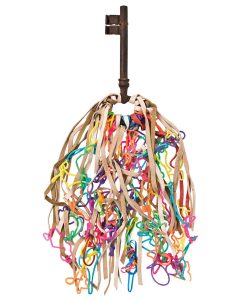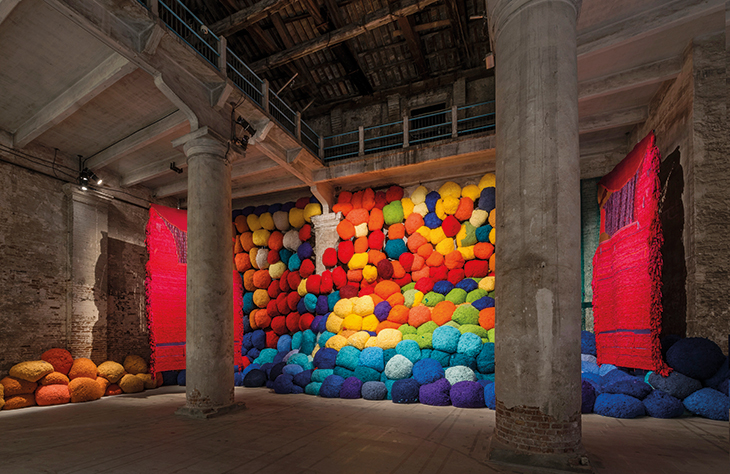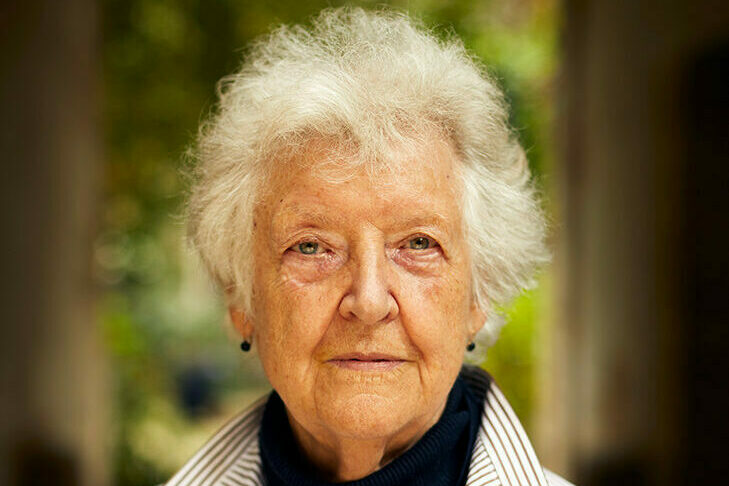From the September 2021 issue of Apollo. Preview and subscribe here.
The studio is luminous, compact, tiled with the clay hexagons more commonly found further south, and in this honeycomb frame a hum of rapt activity is rising. Spools of crimson thread come off well-ordered shelves. Three women are moving furniture, setting a stage for serious play. They carefully unwind the thread, coil it from one end of a workbench to the other, secure it with loose knots and begin a cyclic journey, looping and looping until the strands are held in tension. Sheila Hicks (b. 1934), dressed in lemon pleats, conducts their movement. In English, in French, in final gestures, decisions are made. Deeper shades of yarn fly down a ladder. A marriage of colours is being improvised. What are they constructing? On the far wall hangs an answer: a mass of silver tresses, cinched in green and blue. A brilliant finish suggests silk. It is like the sea going into battle. It demands to be touched.
I have come to interview the artist, but whatever I had planned to ask dissolves in this office of soft forms and slow adventure. It is late July in the Cour de Rohan, a secret world of ivy and pink stone in the heart of Paris. We are steps from Saint-Germain and the bustle of cafes, but behind the green gates all is still. Hicks has been here since the 1970s: working on the ground floor, sleeping upstairs, sharing the courtyard with hollyhocks and motorbikes, the ghost of Balthus, the Fondation Giacometti, and the city’s last remaining pas-de-mule, an iron tripod that once helped older riders mount their steeds. It is the first thing Hicks points out when I visit, and in its timelessness – it could be Bronze Age or Bauhaus – I find a key into her world.
Amathyst Forest (2020), Sheila Hicks. Photo: Michael Brzezinski; courtesy Alison Jacques, London; © Sheila Hicks

Hicks has spent her life manipulating thread, stretching its language beyond ornament and function. Her fibre sculptures radiate chromatic energy and gorgeous heft. Some weavings are like quiet poems with witty titles: Magnetic Love Affair (1998) consists of two string balls in muted tones; a lofty slate-grey mane, like Cousin Itt grown old, is labelled Menhir (1998–2004). Some are postcards from half-dreamed places: Hangzhou, Atacama, Malmö. Some are overwhelming environments. She once installed a totem-like fabric cascade that seemed to pour from thin air into a Belgian lake. On foggy days the sculpture appeared to rise into the mist. A film by Hicks’s son, Cristobal Zañartu, documents the making of an impossibly long tapestry for a theatre facing Mount Fuji. Five tons of pure linen translate all the volcano’s moods. The effects are botanical and startling.
Joie de Vivre (2013), Sheila Hicks. Photo: Michael Brzezinski; courtesy Alison Jacques, London; © Sheila Hicks

Tradition and high tech interlace and are not easily told apart. High up a wall in the studio is a long tubular basket – a ‘bamboo wife’ from Korea, used as a pillow on hot summer nights – which I mistake for one of her own pieces. ‘I don’t think I could make that,’ she protests. Hicks is a restless innovator, but her reverence for craftsmanship runs deep. Her instincts are those of the chiffonnières, ragpickers of old: keys, quills, shoelaces, a mason’s compass and fishing nets have entered her lexicon. A large bicycle wheel from Sweden hangs overhead, left over from an exhibition where an arrangement of such wheels was suspended in mid-air, forming a cosmos of intersecting spokes. A bicycle, we discover with Hicks, is a kind of textile. So are books. She shows me cherished volumes she has wrapped in coloured thread. ‘What do you do with books you have read?’ she asks, as if the purple satin brick I am holding were the obvious answer. We are looking at a catalogue of Chinese sculpture – creaturely forms striking anarchic attitudes – when Cristobal, who is passing through, observes: ‘It takes a lot of discipline not to make something symmetrical.’
At 87, Hicks is the liveliest mind in the room, the one on whom nothing is lost. Fresh work is underway for more commissions than I can count: autumn fairs, galleries near and far, a retrospective at the Hepworth Wakefield next year. Half the show will be conceived with David Chipperfield’s architecture in mind. She tells me she has always liked to invent pieces for a particular space. Materials are often chosen in order to solve problems, like fire or rain. Three years ago, walking along the High Line in New York, she wondered about life in a glass building and began designing screens to keep out prying eyes. She shows me a swatch of cotton gauze woven with dried corn husks, slender as spindles. It makes a thrilling blind, its appeal both primeval and cutting-edge.
Born in Nebraska, where she learned to make things with her three great-aunts, Hicks was raised all over the United States; of Detroit, where the family settled in the 1940s, she remembers the Diego Rivera murals at the Art Institute, and collecting string and metal for the war effort. Hicks has described the formative influence of the years spent at the Yale School of Art in the late 1950s, and of two teachers in particular: Josef Albers, with whom she studied the psychic effect of colour, and George Kubler, who acquainted her with pre-Columbian art; she decided to write about textiles after attending a lecture on Peruvian mummy bundles. Albers introduced her to his wife, Anni, who was a weaver. ‘To me,’ Hicks has said, ‘her work felt constrained by repetition, as if she were pushing herself to do something in the proper way. Throughout my life I’ve resisted those kind of constraints. I try to discover a non-linear way of expressing my ideas, to incorporate the past, present and future all at once.’ While still a student, she threw herself into vernacular ways of making. A Fulbright grant took her to Chile, from where she began an enormous solo trip through South America. Mexico was determining; she settled on a bee farm, weaving things by contriving upturned tables into looms. She shows me her black-and-white studies of stone buildings in Yucatan. It was useful to travel with a camera: ‘Nobody bothered you.’
In my favourite image of Hicks, taken by Cristobal in the courtyard, she is a half-woven thing: her upper body is concealed by one of her creations, a giant textured fan the colour of chalk. I ask what she gained in the move to Paris, her home since the 1960s. She points to the reels of raspberry thread around us, from which combed lengths are slowly being teased. ‘Linen.’ A typical answer – sensual and precise. ‘I had been using South American cloths. I continued with the alphabet of what I knew, but I added linen. It’s not animal. Linen is more like grass.’ Her larger works emulate the splendour of the natural world – its epic appetites, its sheer rude health. When I am at the beach a few days after our meeting, all the seaweed on the shore is plagiarising Hicks.
Grand Boules (2009), Sheila Hicks. Photo: Michael Brzezinski; courtesy Alison Jacques, London; © Sheila Hicks

In an interview with Monique Lévi-Strauss, a textile historian who wrote the first book on her art (a tassel hangs from the spine), Hicks described taking her early weavings to MoMA and being told by the director, Alfred Barr: ‘Can you make these larger?’ She could, and the work never stopped growing. Commissions for designers and corporations drove her to make pliable structures on a monumental scale. There were embroideries for Boeing, a tangle of nylon and silk wires for IBM, a massive wall of gold medallions for the Ford Foundation headquarters; in 2014, because the work had been damaged after half a century of display, she spent a year remaking the whole thing by hand –‘one of the most important decisions of my life’.
From long spells abroad, she absorbed new techniques and bent them to her purposes. In Kerala in the 1960s she worked at a hand-weaving workshop, designing textiles for export. At the end of the day she would pick up scraps of cloth on the floor and turn them into small artworks. ‘There was an osmotic cross-fertilisation,’ she has said. ‘Large to small and small to large, continuously.’ In Morocco she made prayer rugs, but took them off the floor and hung them on the wall. Nor was this the only innovation: she scissored the wool into bas-reliefs, allowing arched portals to emerge from the heavy pile. At the tapestry biennial of Lausanne in 1977, she broke ground by sculpting an avalanche of white cotton laundry – nurses’ blouses borrowed from neighbouring hospitals. My impression is of a life well knitted together, a net embracing the world and taking everything with it. In the studio, the photographer for this story is training his lens on a pile of rope by the window. Hicks insists he include the bulky machine beside it. ‘I think the radio is important,’ she says. ‘How do we live today? With bicycles, with radios. We want to make poetry but we have to deal with chewing gum.’
Escalade Beyond Chromatic Lands (2016–17), Sheila Hicks (installation view at the Venice Biennale in 2017) Photo: Michael Brzezinski; courtesy Alison Jacques, London; © Sheila Hicks

Work advances on the raspberry lianas. A piece like the one in progress was recently hanging at the Centre Pompidou, part of a large group show on women in abstraction. Here she was among fellow pioneers, after decades of working against the grain; an exhibition of 72 artists at the Grand Palais nearly 50 years ago included only two women: Hicks and Sonia Delaunay. By pursuing the modernist investigations of her male contemporaries in woven form, Hicks gave them more complex expression. Colour, line and texture, sound and light happen at once and animate each other. The hardest challenge, she tells me, was to convince the French to respect her chosen medium. ‘The prejudice against the material was stronger than against my being a woman.’ This was not the case everywhere. She shows me pictures on her phone of sculptures – semicircles of radiant colour, like rising suns – she made in the early ’80s for an all-male university in Saudi Arabia (‘12,000 MEN AND A WOMAN’ was the New York Times headline at the time).
When I return to the studio two weeks later, the lianas have acquired deep blue belts. Janissaries come to mind. How does the thread look so metallic? The answer is metal. In the late ’90s, Hicks was invited to Japan to make a doncho, or stage curtain, for a cultural centre. She asked around for fireproof materials and found a tyre company making stainless steel thread, who gave her some to experiment with. The fibre was too heavy to be used for the curtain (‘if it fell,’ she says calmly, ‘it would kill everybody on stage’) so she completed it with other materials and saved the steel. Now and then it surfaces in her pieces, lending shine and surprise; the sequential heating and cooling of the thread produces unpredictable colour.
Escape to the North (2013), Sheila Hicks. Photo: Michael Brzezinski; courtesy Alison Jacques, London; © Sheila Hicks

Silence descends on the hive. Hicks takes up a small piece she is weaving. She has been making miniature works, called ‘minimes’, since art school. They are laboratories, little exercises in disobedience, made on a small wooden frame and always searching for ways to slip their body plans. They are like notations of a dreamy scribe. Some break the surface plane, digressing into the third dimension. Some have the structure of jokes.
Nearby an assistant is working on a white piece: linen crossed with hand-spun wool. I am invited to touch, to feel the different textures. Hicks runs a finger along the weft as if deciphering braille. Squares of different sizes create movement and depth. ‘We discovered that when you make mistakes it’s more interesting,’ she says. From the cultivation of such accidents – wrinkles, ravels, warp ends hanging loose – she has forged a distinctive idiom. Thread is forever threatening to become a holy mess. Her works often appear to dramatise a struggle between mischief and control. They dance on the edge of chaos. One is titled Indecipherable Code (2005).
Where is the thread from? ‘We wish we knew,’ she says. (Hicks often speaks of her practice in the plural; a shifting stable of weavers has assisted her for decades.) Soon we might know more. Perhaps the most exciting of the current commissions is a new installation for the Gobelins, the historic heart of France’s weaving industry. ‘When I arrived in Paris, I was not considered a properly trained licière. They thought I was an alien.’ She plans to invite all the sheep farmers in France to lend her a bale of wool. Raw, unspun? ‘Maybe unwashed,’ she says with pleasure. ‘Maybe it will smell.’ Here comes a vindication, an opportunity for irreverence in the world’s most conservative tapestry works. ‘I want people to come in and be surprised, not intimidated… and for each person to figure out what it means for them.’ In the ’60s, she says, they would have thrown her out. Now she is invited to the altar – a sign of the world catching up.
Sheila HIcks photographed in the courtyard outside her studio in Paris in August 2021. Photo: Samuel Kirszenbaum

From the September 2021 issue of Apollo. Preview and subscribe here.



